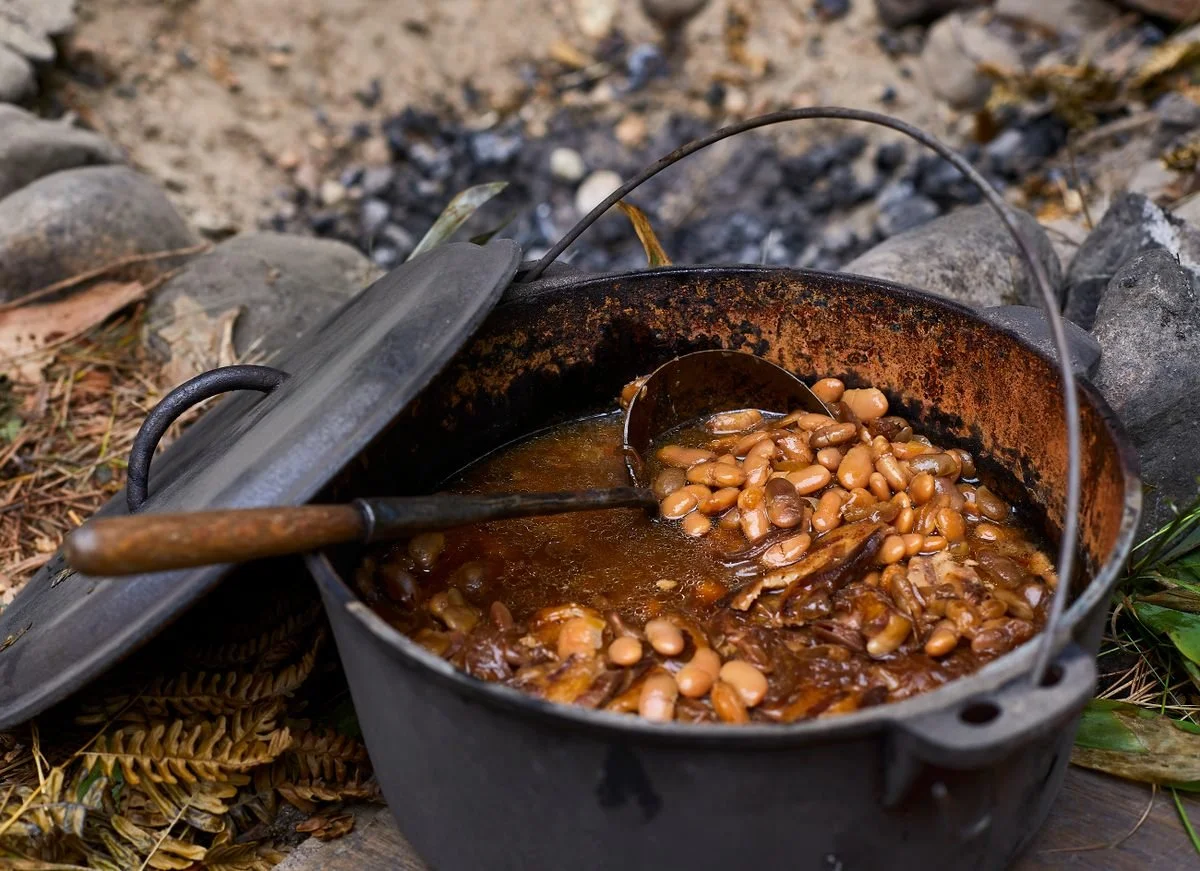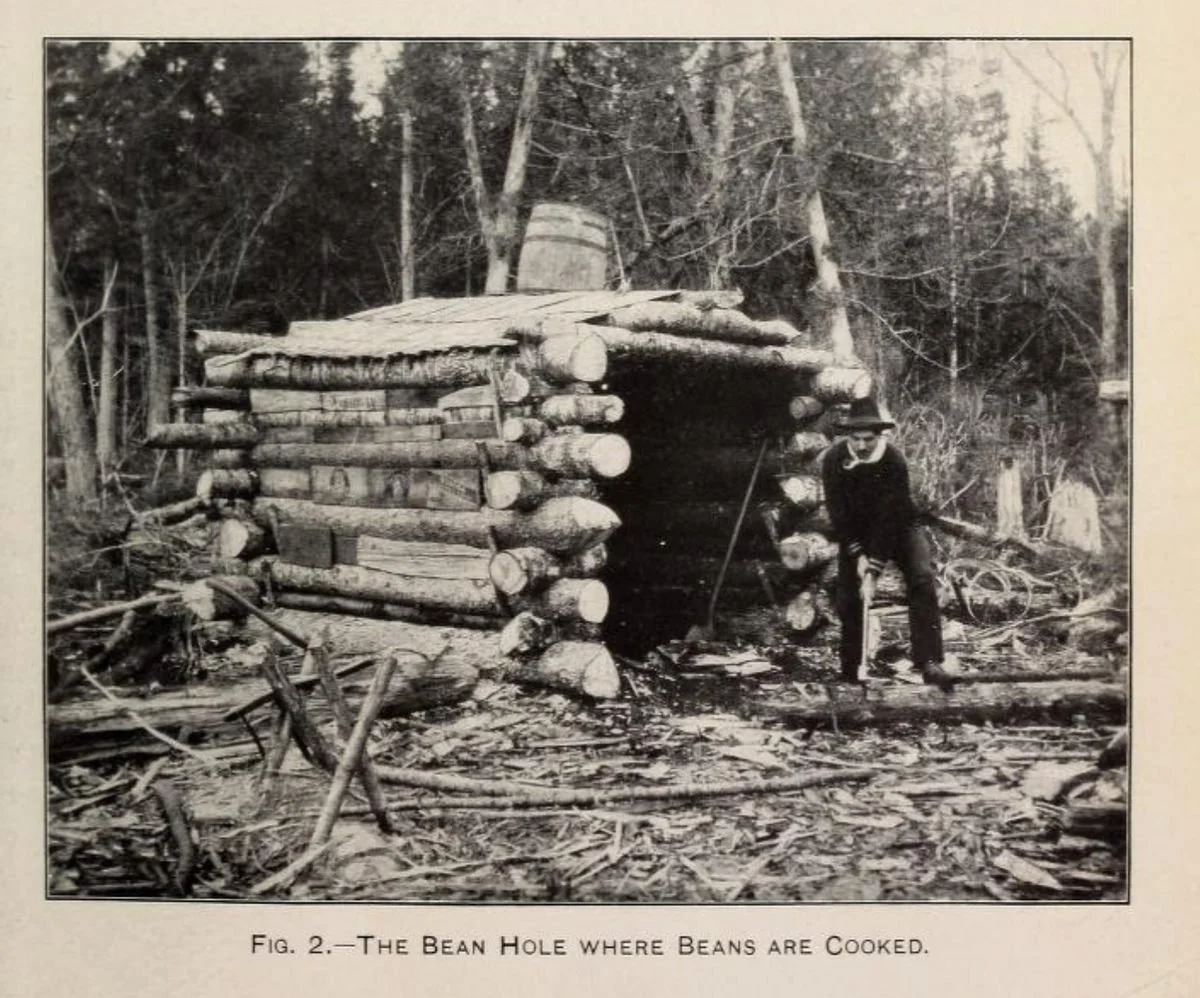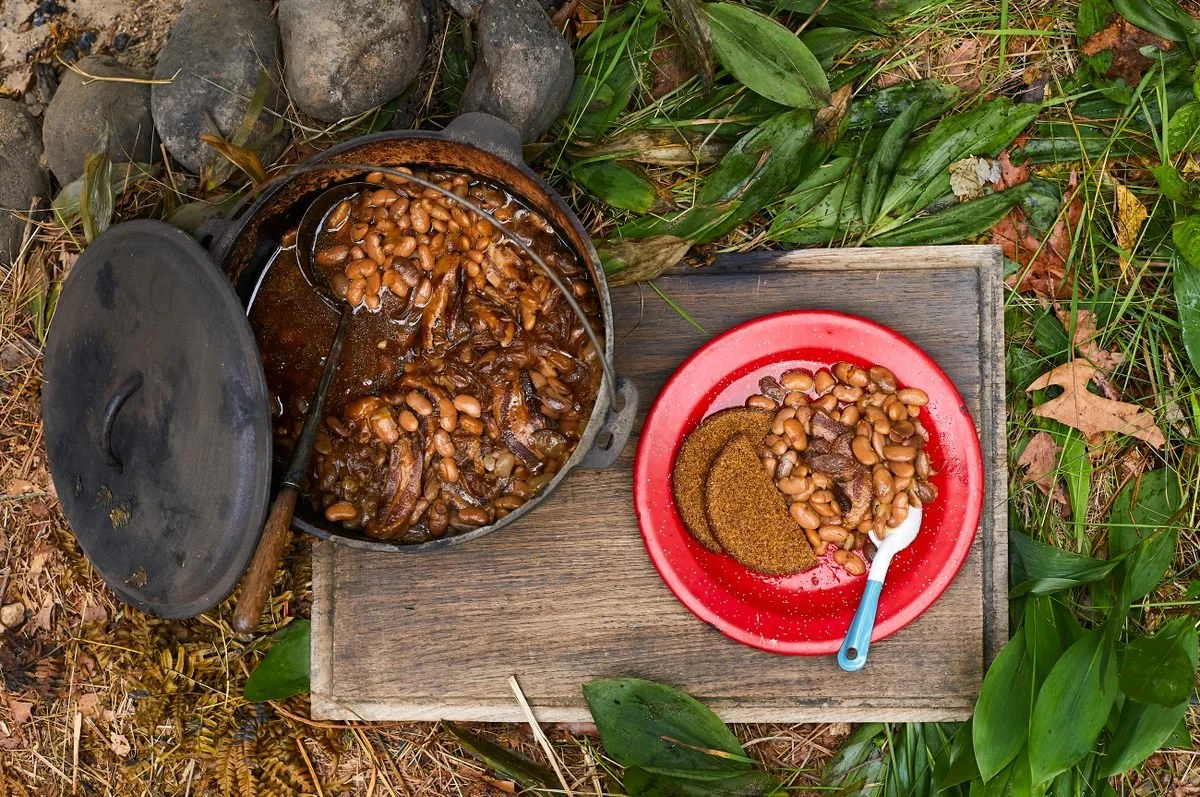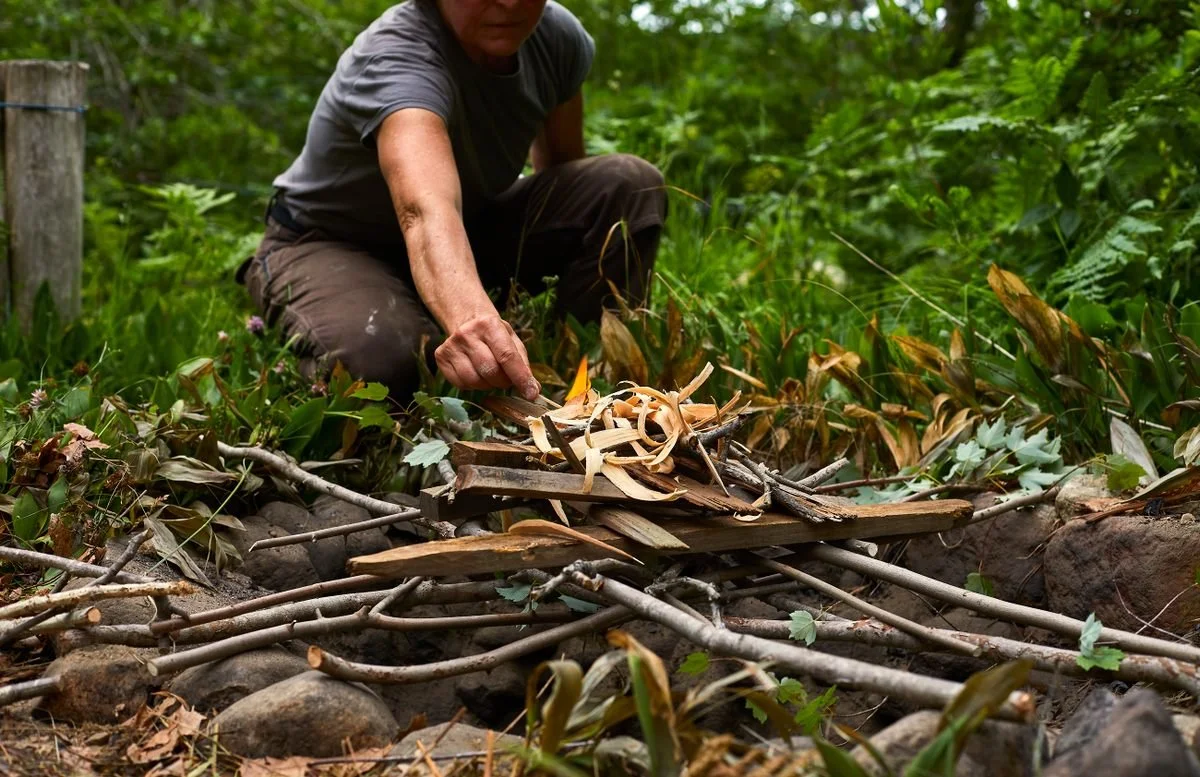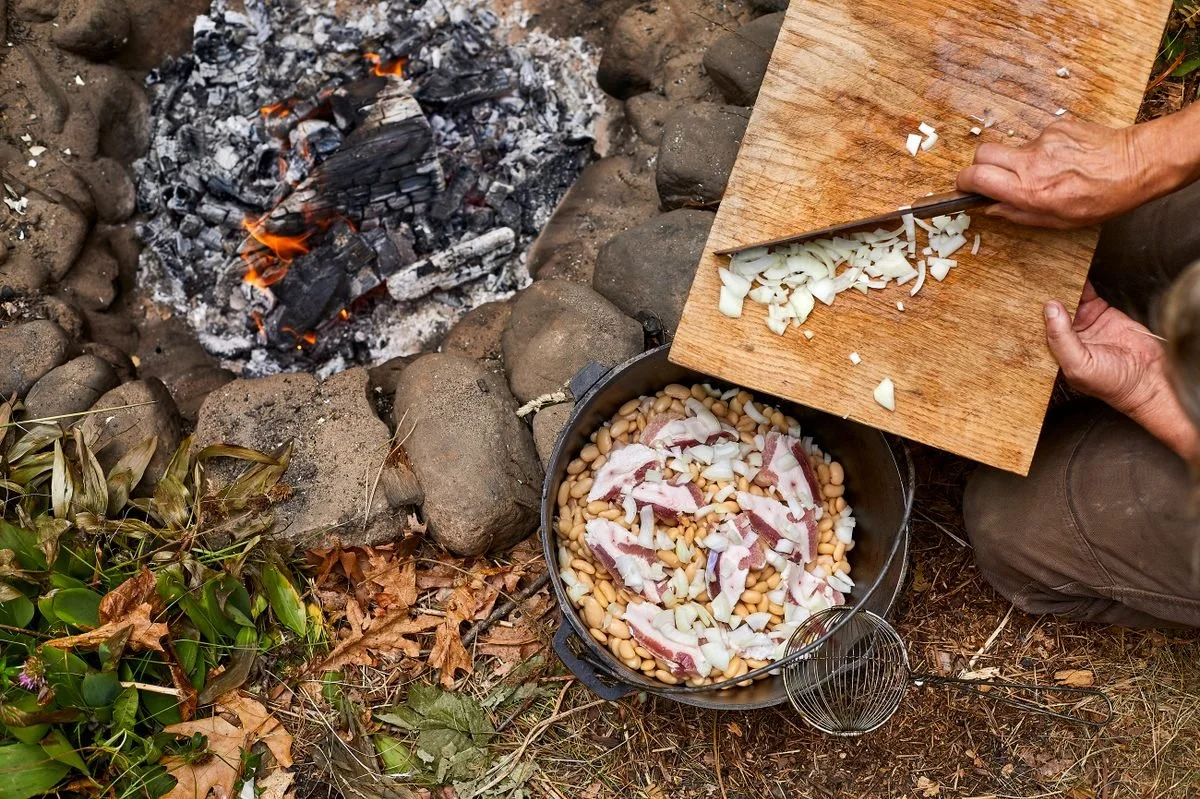In the middle of the Maine winter in 1902, a young scientist convinced six lumberjacks to act as his test subjects. He recorded every morsel of food the men were planning to consume for a single 18-meal workweek. He then gathered all the pertinent excrement, put them in "museum jars," and stored them in a snowbank stash. He also put together and frozen samples of each type of food supplied to the men with the camp cook's help. He then brought all of these ice jars to the University of Maine at Orono's Maine Agricultural Experiment Station for examination.
A group of men pose at Russell Camp, another camp for loggers in Maine, circa 1900. PUBLIC DOMAIN
The study was a part of a wave of early investigations into metabolism and digestion that would later lay the groundwork for the emerging area of nutrition science. In addition, it paints a remarkably accurate picture of the diets of lumberjacks at the turn of the century. The study's participants were highly physically fit Canadian immigrants in their late 20s who worked long hours performing "severe work under more or less trying conditions," as the study's authors described it.
The loggers consumed a diet high in calories and protein to fuel their strenuous work. The salted fish—cod, herring, and salmon—as well as fresh or salted beef and pork—served as stews, boiled meat, roasts, and side dishes of potatoes, cabbage, and turnips—made their way across the menus. Doughnuts, pies, cakes, and cookies were always available, as well as hot breads, particularly sourdough biscuits. However, when it came to "the most important single article of diet," the study found that baked beans were superior to all other foods.
All of these filling, nutrient-dense foods had been mainstays in 19th-century America, but as the 20th century got underway, "respectable" indoor people began to marginalize the "coarse fare" that was still the foundation of rural diets. For most Americans, baked beans represented the most primitive food imaginable, and they were the staple of the logging camp.
Baked beans were “the most important single article of diet,” among lumberjacks, the study said. ANGEL TUCKER FOR GASTRO OBSCURA
Before capitalists exploited them as a weapon to assist the region's deforestation, baked beans had a long history in New England, but nowhere were they as essential and pervasive as in logging camps. They were served in large quantities at at least two meals per day. Before railroads made it easier to supply camps, fifty years prior, when Henry David Thoreau traveled through rural Maine, he learnt of the much sparser and less dependable diet for loggers—tea, molasses, hard bread, salt pork (often raw), and beans, plenty of beans. “A great proportion of the beans raised in Massachusetts find their market here”, he noted dryly. In the time between Thoreau's visits and the science experiment at the University of Maine, farmers not only opened clearings along the rivers, planted beans, potatoes, corn, and turnips, and raised dairy and meat animals to supply the lumber camps, but also laid hundreds of miles of rail.
The bean-hole and the lumber camp
While a single, long, log-built structure essentially served as the entire domestic infrastructure for a 50–60 man camp—dormitory, cookroom, dining hall, and food storage—only one daily function—the lean-to guarding the bean-hole—was important enough to deserve its own construction. Every day, a cookee (the cook's assistant) would light the pit and cook a batch of soaked beans over the cookroom fire, just long enough for the skin to wrinkle when the beans were exposed to air. Then, he would place them in the bean kettle with salt pork, onions, and possibly dry mustard, drizzle on a generous amount of molasses, tighten the cover, bury the kettle in the bean-hole with hot coals and earth, and leave it there overnight to be picked up the following morning for breakfast. Then he would repeat everything.
Over the past century, a lot has been written about lumberjacks, including the fact that they consumed a lot of beans. However, many of these accounts are anecdotal and embellished by a bro-mance, a sedentary and selective view of the bygone era of manly men engaging in manly activities. In any case, numbers are always missing, even if the source is reliable.
The bean-hole the study’s lumbermen used in 1902. PUBLIC DOMAIN
In contrast, the University of Maine study, titled "Studies of the Food of Maine Lumbermen," was first published in a USDA bulletin in 1904. Despite the fact that the researchers' study was well-designed and the accompanying data is a veritable gold mine for the food historian, they were a few decades too early to understand what a vitamin was. Granted, it demonstrates that the loggers did consume a significant amount of beans, but when quantified, it becomes much more intriguing. Beans were clearly shown to be the main source of calories for every male in the research, despite the abundance and variety of meat on the table and the pyramids of doughnuts and sugar sweets. They all consumed strikingly similar amounts of baked beans every day, ranging from a pound to a pound and a half, providing between 10 and 16 percent of their 6,000–8,000 daily calories and one-fifth to one-third of their protein intake, despite the fact that their personal preferences were obviously different.
The most mentally and physically taxing and outright dangerous aspect of the task was the river drive, when a team was out for about 10 days guiding the logs down the river as the ice broke up. Even the times when the men weren't working were miserable because they frequently slept in tents while being wet to the skin. The guys would receive meals at intervals of several hours while working from early daybreak till after midnight, eating wherever the cookees found them.
Baked beans were essential during this most trying time of the operation because they made up the majority of the diet, which included up to five meals a day of just sourdough biscuits, cookies, tea, and molasses. The authors of the study noted that "These conditions might naturally tend to lessen the appetite." The men consumed 25% less food overall and generally lost a couple pounds from their already trim frames without a full menu of meat dishes and pastries. The majority of the calories and protein needed to keep them going came from baked beans.
Six of these Canadian lumberjacks were featured in the study. PUBLIC DOMAIN
In Maine in the late 20th century, when traditional logging camps and river drives fell out of favor, bean-hole beans found new supporters among outdoor enthusiasts whose values were more in line with Thoreau's half a century earlier than with the loggers of 1902. The bean-hole method was popularized by authors of hunting, fishing, and scouting manuals, but not without a warning to tenderfoots:
Baked beans are strong food, ideal for active men in cold weather. One can work harder and longer on pork and beans, without feeling hungry, than on any other food with which I am acquainted, save bear meat. The ingredients are compact and easy to transport; they keep indefinitely in any weather. But when one is only beginning camp life he should be careful not to overload his stomach with beans, for they are rather indigestible until you have toned up your stomach by hearty exercise in the open air.
–The Book of Camping and Woodcraft: A Guidebook for Those who Travel in the Wilderness, by Horace Kephart)
If you have that piece of advice, a large kettle, a shovel, and a few other oddities, you might be excavating your breakfast tomorrow too.
A 1907 river drive in eastern Ontario. PUBLIC DOMAIN
Beans with holes
Timing
The day before you want to dig up and serve these beans, start. Although this may seem like a lot of labor, keep in mind that the final 16 hours or so require absolutely nothing from the cook because the cooking is done underground while you sleep, party, or do whatever else it takes to work up an appetite fit for a lumberjack.
Gear
A sizable cast-iron pot with a bail and a tight-fitting, heavy cover is required, along with excavating and fire-tending equipment. Find something to serve as a second barrier to keep sand, dirt, or ashes from getting inside if your pot's cover is at all flimsy or light, or if you're a Nervous Nellie like me. I've used odd pieces of aluminum, ferns covered in old shingles, the lid of a large enamel pot, and other things on various occasions. I once found a recipe in an outdoorsman's guide that instructed producing a flour-and-water paste gasket for your bean kettle.
You need a mix of dry, small-split wood—both hard and soft—for fuel.
Beans accounted for one-fifth to one-third of the lumberjacks’ protein intake in 1902. ANGEL TUCKER FOR GASTRO OBSCURA
Ingredients
Beans. You can use Navy, Great Northern, Cannellini, or virtually any full-flavored, robust bean you desire. Old-fashioned New Englanders like us like our Marfax, Yellow Eye, Jacob's Cattle, and Soldier beans, but you can use these instead.
Pork salt. Regardless of baking method, this savor-bomb is what gives classic New England beans their particular richness. To season 2 pounds of beans, lumber camp cooks used up to 212 pounds of salt pork; in other circumstances, a half-pound might be utilized.
Keep your own salt pork on hand for optimal results: In a sealable tub with some room around it, sprinkle a piece of pork belly with kosher salt on all sides. Then, add a brine you make by dissolving additional salt in cool water until it tastes like sea water. Cutting off chunks and topping up with fresh brine to keep it completely buried, seal the tub and keep it in the refrigerator until needed.
2 pounds dry beans
½ to 2 teaspoons salt, depending on the amount and saltiness of the salt pork
1 teaspoon freshly ground black pepper
1 teaspoon dry mustard (optional)
3 tablespoons molasses
1 medium onion, sliced
½ to 2½ pounds salt pork
Make a lattice of green sticks across the mouth of the pit, create a “cob-house,” of dry sticks atop it, and set that alight. ANGEL TUCKER FOR GASTRO OBSCURA
1. The beans should soak for six to eight hours in plenty of cool water.
2. Dig the beanhole in the meantime. With just the correct amount of room on both sides for hot coals and earth, the bean-hole should be simple to maneuver the kettle into and out of. So anticipate a cylindrical pit with a flat bottom that is at least a foot deeper and roughly twice as wide as your bean kettle. As you dig, take that into consideration whether you intend to line the pit's bottom and sides with stones, which is optional but attractive.
3. About 18 hours before you want to serve the beans, start the fire. Take it easy on yourself by having lots of excellent, dry tinder and kindling wood on hand because starting a fire in a damp tight pit can be difficult. This procedure would be rather quick and simple at timber camps where a bean-hole would be covered by a lean-to and utilized continuously. On a muddy trail, it can be challenging to heat a freshly dug bean-hole.
One author from the era, a trapper, provides this practical tip: Create a "cob-house" (an airy stack of dry sticks stacked at right angles like a log cabin) on top of it, light it on fire, and then make a lattice of green sticks to span the mouth of the pit. As you can, keep adding gasoline because eventually everything will fall into the pit and you'll be on your way. Regardless of whether you employ this strategy, after your fire has started, burn it steadily for around two hours at a moderate pace. Hardwood and softwood blends are ideal.
Layer the beans in the kettle with salt pork, onions, and a mixture of broth, salt, pepper, and molasses. ANGEL TUCKER FOR GASTRO OBSCURA
4. To parboil the soaked beans, add water to cover by two inches, if necessary. Place them over a medium flame, skimming the froth as you bring them to a very gentle simmer. When you dredge up a few beans and blow on them, the skins should wrinkle. Cover the pot and cook over low heat until that happens. Generally speaking, this process takes at least an hour, but it fully depends on the age and caliber of the beans.
5. Slice the onion, then scatter it in the bean kettle's bottom. Pour roughly half of the beans on top. Slice the pork or leave it whole and make cross-hatching cuts into the rind with a knife. Layer the remaining beans in the pot after adding the pork, keeping the broth aside.
6. In a small bowl, combine the molasses, salt, pepper, optional mustard, and molasses. Pour part of the bean broth in and mix everything together. Finish by adding extra bean broth (or boiling water if you're out) to cover the top beans by about an inch. Pour over the entire dish. It should be heated over a low flame so that it will be simmering when it is buried.
7. If you are concerned about the safety of your pot lid, take action right away. You can either build a sacrificial gasket by blending a very thick slurry of flour and water and pasting it around the lip of the lid to seal it, as indicated in the "Gear" remark above, or you can jury-rig a protective "helmet" to protect yourself.
Bury the kettle and let the beans cook for at least 12 hours. ANGEL TUCKER FOR GASTRO OBSCURA
8. In the meantime, assemble everything you'll need to properly insert and cover the kettle. When everything is prepared, remove any sizable pieces of unburned wood using a long shovel or a pair of fire tongs. Smaller embers and coals should be pushed to the pit's edge so that the kettle will rest upright and firmly at the bottom. Carefully drop the kettle into the pit's middle. (If there is a lot of loose, hot earth and ashes in an unlined pit, scoop some out first and pile it nearby so you can easily nestle it around the pot.)
At this point, some authors advise stacking plant material around and over the pot; I've loved adding a thick layer of green bracken, but I can't guarantee that it changed the outcome. The worry-warts among us may be calmed by laying down a sheet of metal or a thin covering of clapboards before the earth is covered. In any case, pile dirt on top of the bean bake.
9. Bake the beans for at least 12 hours, though we've found that longer is good. Try to be aware of the dirt at each turn as you dig the pot up. Avoid upsetting your defenses before they are ready. A little hand broom comes in handy.
If there are any leftovers after cooking, they are just as delicious when warmed up.


